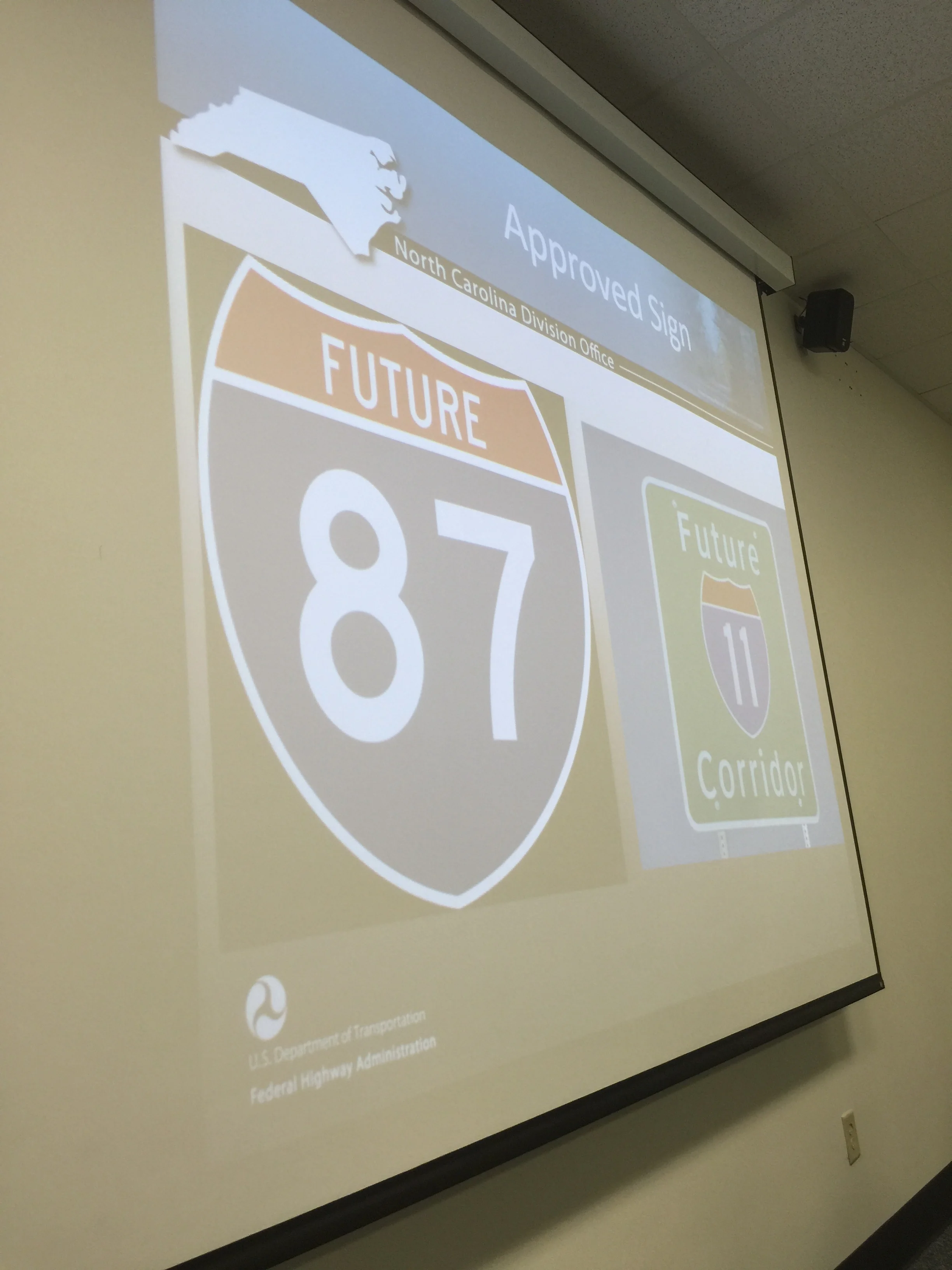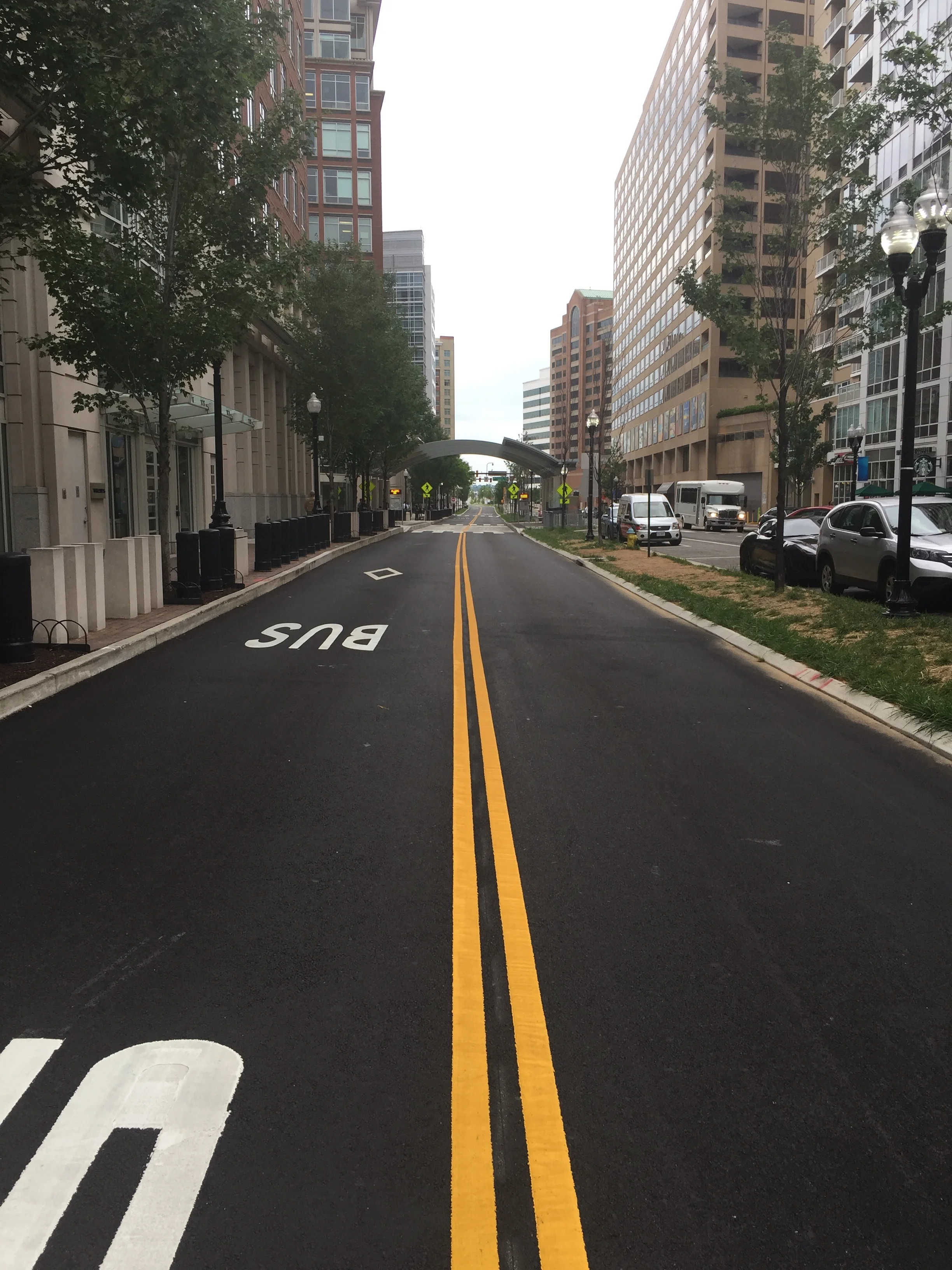A bipartisan gift to our prosperity
This blog post is about the cooperative efforts to develop a new Interstate corridor between Raleigh and the Hampton Roads metropolitan region of southeastern Virginia, via Rocky Mount, Williamston, and Elizabeth City in northeastern North Carolina.
While there is still much more to do, there has already been significant success and a level of cooperation that promises more results. If you are looking for a bipartisan success story on transportation – this is it.
Let’s begin with the existing I-495 success west of Rocky Mount, and then talk about the balance of the corridor.
Interstate 495 North Carolina – linking the Capital City with the East Coast’s Interstate
If you live in or have traveled in eastern Wake County during the past several months, you have seen the new signs for I-495, North Carolina’s newest Interstate. The westernmost portion of the US 64/264 bypass between Raleigh (I-440) and Knightdale (I-540) now carries the additional designation of Interstate 495, and when the first overhead signs for I-495 appear on I-440 and I-540 later this fall, the designation will gain wider visibility beyond a few ground-mounted signs and the occasional appearance on Google maps.
Continuing east along US 64 from Knightdale, NCDOT has posted new “Future 495” signs all the way to I-95 at Rocky Mount. Already, there is an understanding of the benefits of the increased visibility to communities in eastern Wake, Franklin, and Nash counties. I presented to the Carolinas Gateway Partnership economic development organization in Rocky Mount in mid-August, and the elected and business members there clearly understood the positive implications of the new designation.
From a Regional Transportation Alliance perspective, which focuses on the Research Triangle region, we realized the major accomplishment of creating a new Interstate connection between the North Carolina’s capital city of Raleigh and I-95 north when Governor McCrory made the announcement of the new Interstate designation to hundreds of business and elected leaders at our annual meeting in December 2013.
Future primary Interstate corridor – linking Raleigh with coastal Virginia/Hampton Roads area via Northeastern North Carolina
The Regional Transportation Alliance business coalition has continued to pursue an Interstate designation for the broader corridor east of Rocky Mount, to Williamston, Elizabeth City, and Hampton Roads in cooperation with other groups and organizations.
From the federal side, bills have been introduced in the House by Congressman Butterfield – with 10 of the 12 members of the state’s US House delegation already having signed on as a sponsor or co-sponsor – and in the Senate by Senator Hagan, with Senator Burr cosponsoring. That means bipartisan support in both chambers.
At the state level, both Governor McCrory and NCDOT Secretary Tata have extended their support for this critical project.
At the local level, a number of jurisdictions in the Albemarle region have passed resolutions of support for the initiative, including Edgecombe, Martin, Pasquotank, and Beaufort counties, the City of Elizabeth City, the Town of Williamston, and the Highway 17 Association which has spearheaded several of the resolutions in northeastern North Carolina. In southeastern Virginia, the Chesapeake Division of the Hampton Roads Chamber of Commerce endorsed an Interstate designation for the corridor earlier this month.
Completing the entire 200 mile corridor and creating a new connection between Raleigh and Hampton Roads will not happen overnight, or even “over decade.”
Given the complexity of the task, this effort has to be thought of as a gift that we will give to our children’s future prosperity. It took almost ten years from our first Interstate designation request of NCDOT for this corridor until approval by the American Association of State Highway and Transportation Officials (AASHTO) and the Federal Highway Administration and the subsequent posting of Interstate and future Interstate signs for the western portions of the corridor earlier this year.
Economic benefits
NCDOT Secretary Tony Tata has highlighted the importance of this initiative. In a letter to Congressman Butterfield, he noted that “The future Interstate designation is critical to further economic development in the region. The designation will enable businesses near and along the corridor to grow because they will have the promise of a future Interstate to connect between these two vital centers of commerce in the Raleigh and the Norfolk/Hampton Roads region of Virginia… The designation is an important part of our future vision for transportation in our State and is key to promoting job creation and aligning our infrastructure with commerce activity.”
Ms. Adrienne Cole, who serves as executive director for Wake County Economic Development – and also serves on the board of the Raleigh-Durham Airport Authority – has similarly noted that “Transportation is one of the major factors that site selectors evaluate when making decisions on the location of new businesses, including Interstate access. Proactive efforts to enhance our transportation network, including new and future Interstate corridors, will pay off both in the short-term and in the future.”
Franklin County in the immediate Triangle area and several northeastern North Carolina counties would receive their first direct access to the Interstate system. For many of these counties, this future Interstate corridor is the only plausible way that they could have that access in the foreseeable future. It will quite literally put them on the map from an economic development standpoint.
Of course, this Interstate effort alone will not solve all of the economic challenges facing northeastern North Carolina, but it can certainly help, by providing an economic lifeline to counties that need it and link urban, suburban, and rural job centers together.
Corridor improvements, and impacts on businesses and communities
More than 50% of the corridor is built to freeway standards. This includes the entirety of US 64 from Raleigh to Rocky Mount and Williamston – with some portions at Interstate standard – as well as freeway bypasses at Windsor, Edenton, and Elizabeth City along US 17.
From a planning standpoint, the improvement of the US 64 freeway west of Williamston will primarily involve the widening of shoulders and adjustment of bridge clearance heights where necessary. These are initiatives that, were funding immediately available, could likely be completed very quickly, because there is no significant planning exercise to undertake, as the entire corridor is already a freeway.
For the remainder of the corridor – generally following US 17 – the process will, and should, take longer. To that point, leaders in some communities in the Albemarle region of northeastern North Carolina have expressed legitimate concerns about the potential impact to business and residents.
While we are way too early in the process to know all of the specifics of how the development of a new Interstate corridor would impact any community, here is a suggestion for anyone – citizen, town, county, business, etc. – that is supportive of the Interstate at a conceptual level but still has concerns or reservations due to the (unavoidable at this stage) lack of details of what that the future Interstate would ultimately look like throughout the entire alignment: Consider endorsing a resolution along these lines to demonstrate support, while incorporating additional language that would speak to local concerns of community and economy. For example:
(Our community/business/organization/etc.) supports the broad concept of a new Interstate corridor that will link Raleigh, Northeastern North Carolina, and Hampton Roads, and recognizes the benefits to our future prosperity.
For all non-freeway segments, we expect that options for either upgrading the existing corridor and redirecting access to businesses and/or creating portions of new location highway will be explored, compared, and addressed during the advance planning phase – with ample opportunity for public engagement – with the goal of maximizing prosperity and economic opportunity while minimizing impacts to our community’s current and future residents and businesses.
While these and other concerns and objectives will indeed be considered during the extensive required planning process and public engagement by NCDOT in cooperation with local communities and various Rural and Metropolitan Planning Organizations, language along the lines of the above would say, in effect, “You can count on our support for a new Interstate for our region – let’s all work together to ensure that the new highway is a true improvement for our community and region’s prosperity, both now and in the future.”
And that would be a quite reasonable perspective, and one well worth expressing.
Conclusion
On a personal note – I grew up in rural Pennsylvania, in a town of fewer than 5,000 residents that was directly served by a non-freeway US highway linking several metropolitan regions. Let’s just say that I never saw the level of focus, cooperation or leadership to the extent that I am seeing from the Governor of North Carolina, the NC Secretary of Transportation, and the US Senators and Representatives from both political parties to advance this corridor.
Kudos to the bipartisan support at the federal, state, and local level for this initiative. A new Interstate designation would be the next step in a century of investment along the corridor, serving a region whose greatest days are still to come.





